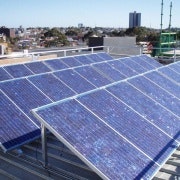The power of the solar voter
Yesterday, the West Australian state government reversed its decision to apply retrospective changes to its feed-in tariff. The WA government realised that its proposal to halve the payment given for excess solar electricity had angered 70,000 voters all in order to save a paltry $51 million.
This remarkable turn-around occurred in the space of four days, but not before the issue made front-page news and caused 13 per cent of the affected to sign a petition. This follows a similar outcome in New South Wales two years ago, in which the government attempted to retrospectively slash the value of payments to solar customers. Following voter outcry, the Queensland Competition Authority was slapped down by Queensland Premier Campbell Newman when it suggested tariffs that would discriminate against solar owners.
With this precedent established, I doubt any Australian government would again attempt to cheat solar customers out of their promised benefit. With a tightly-contested federal election underway, the WA issue threatened to unseat five Liberal Party politicians because the electoral margin was smaller than the number of solar voters.
Ken Wyatt, who held the seat of Hasluck by 500 votes and had 8700 solar voters affected, tweeted his relief following the backdown. Beyond federal Liberal Party pressure upon their WA state government counterparts, the solar industry also should particularly acknowledge state MPs Rob Johnson, who publically expressed outrage at his own Party’s policy, threatening to cross the floor for the first time in his 20 year history, and Peter Abetz who said his own government had acted unethically.
Solar voters are now a political force to be reckoned with. Solar Citizens, a recently formed representative body that protects the rights of existing and future solar owners, were instrumental in pressuring the government to reverse its decision, through encouraging emails to politicians, radio interviews, pressure on federal politicians, media reporting, social media activities, and its 9300-strong petition. Every solar owner should join Solar Citizens (for free) to ensure that:
-- Every Australian is able to take up the benefits of solar in their home or in their community;
-- Solar homeowners are paid a fair price for the power they contribute to the grid;
-- Solar homeowners are able to connect to the grid; and
-- Solar homeowners are not subject to unreasonable charges or tariffs.
Indeed, it is the solar households that differentiate Australia’s solar industry from the rest of the world. Rather than support commercial solar as has predominantly occurred overseas, Australian state and federal governments recognised solar’s popularity amongst the electorate and provided direct incentives for voters to install solar power on their home.
While many in the Australian solar industry lamented the lack of commercial installations, solar voters have prevented retrospective cuts that have occurred in countries where commercial PV is prominent, such as Spain. Already one million Australian households have solar power, enough to shift election outcomes.
It is time that Australian political leaders recognise our importance, and engage with the solar industry. Past solar programs have been announced without sufficient engagement with the solar industry, leading to a boom, overspend, and then painful bust, all because they lacked feedback measures that were responsive to rapidly improving affordability.
It is time to put historical perceptions in the past, and look forward to an inevitably solar future. By 2020 solar will be competitive with fossil fuels, and by 2030 solar power will be our cheapest source of energy and will thus underpin the international competitiveness of Australia’s economy. (Thankfully we are blessed with the world’s best solar resource).
To realise this competitive advantage, governments now need to engage with the solar industry as partners in an energy transformation. In order to smoothly manage the inevitable transition posed by this disruptive technology, you will need the solar industry on side. We represent the 2.4 million people who have bought solar power, and the other 18 million people who will purchase solar in the next decade. Their interests are our interests.
We’ve stood by them before, and now once more we stand. We want to make solar accessible to all. We dislike the uncertainty created by the 2014 RET Review. We will not accept retrospective changes to feed-in tariffs, which are unfair to existing solar owners, and which undermine future solar investment. We will not accept discriminatory tariffs, nor scapegoating solar as the main reason for electricity price rises.
The solar industry recognises that solar power is an inevitable part of Australia’s future. But we foresee the upheavals that will occur if the transition is not well managed. The time is right for state and federal governments to recognise the part solar power will play in Australia’s future.
Now is the time to engage with the solar industry. So that together we can smoothly transition away from a dated electricity model towards a future where there is solar on every rooftop.
Warwick Johnston is the Chair of the PV Directorate of the Clean Energy Council (CEC), and sits on the CEC’s PV Leadership committee and Policy & Advisory Committee. Warwick also contributes to the Australian Solar Council and Australian PV Institute.















